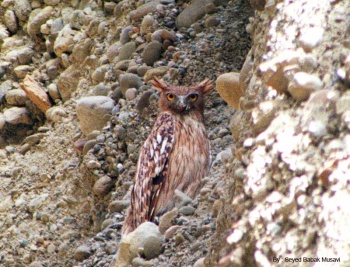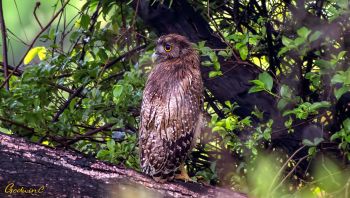- Ketupa zeylonensis
Identification
48–58 cm (19-22¾ in)
- Obvious "horns" usually held horizontal
- Rufous brown upperparts, streaked black
- Obvious whitish to buff markings on the folded wing
- Pale underparts streaked and barred brown
- White throat
- Tail barred brown and buff
- Yellow iris
- Bare parts yellowish to greenish
Juvenile more uniform than adult.
Distribution
Widespread from Pakistan and India east to China and south to Malaysia.
Extremely rare in the Western Palearctic. A small populaton was recently rediscovered in the Taurus Mountains of southern Turkey. May still occur in Jordan in the Yarmuk and northern Jordan Valleys but probably now extinct in the Golan Heights of Syria where not recorded in recent years.
Formerly bred in northern Israel and also recorded in southern Iraq.
Recorded in Lebanon.
Taxonomy
Subspecies

Photo by Seyed Babak Mus
Near to Gaz river in Hormozgan Province, Iran, Spring 2004
There are 4 subspecies[1]:
- K. z. semenowi:
- K. z. leschenaulti:
- K. z. zeylonensis:
- K. z. orientalis:
- North-eastern Myanmar to south-eastern China, Malay Peninsula, Indochina and Hainan
A recent study suggests that K. z. semenowi should be studied further because it may be a full species[3].
Habitat
Lakes, rivers and streams with tree-lined margins, wadis with shrubs in the Golan Heights.
Behaviour
Diet
The diet consists of frogs, fish, crabs, crayfish, mammals, birds and reptiles with the majority of food coming from the first three groups.
Mainly active during night, possibly with maximum at dawn and dusk, but also some reports of hunting during the day.
Breeding
They use old nests made from sticks, or they nest on ledges. The 1 or 2 eggs are incubated for 38 days; the young fledge after about 7 weeks.
Vocalisation
Seems quite variable geographically, but involved two or three note boom or hoo sounds.
References
- Clements, J. F., T. S. Schulenberg, M. J. Iliff, S. M. Billerman, T. A. Fredericks, J. A. Gerbracht, D. Lepage, B. L. Sullivan, and C. L. Wood. 2021. The eBird/Clements checklist of Birds of the World: v2021. Downloaded from https://www.birds.cornell.edu/clementschecklist/download/
- World Owl Trust
- Birdforum thread discussing the taxonomy of Brown Fish Owl
- Holt, D. W., R. Berkley, C. Deppe, P. L. Enríquez, J. L. Petersen, J. L. Rangel Salazar, K. P. Segars, K. L. Wood, G. M. Kirwan, and J. S. Marks (2020). Brown Fish-Owl (Ketupa zeylonensis), version 1.0. In Birds of the World (J. del Hoyo, A. Elliott, J. Sargatal, D. A. Christie, and E. de Juana, Editors). Cornell Lab of Ornithology, Ithaca, NY, USA. https://doi.org/10.2173/bow.brfowl1.01
Recommended Citation
- BirdForum Opus contributors. (2024) Brown Fish Owl. In: BirdForum, the forum for wild birds and birding. Retrieved 27 July 2024 from https://www.birdforum.net/opus/Brown_Fish_Owl
External Links
GSearch checked for 2020 platform.1







